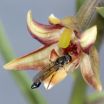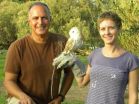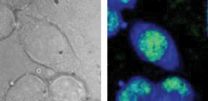(Press-News.org) Even Darwin was a self-admitted orchid lover. Dictionaries describe orchids as exotic ornamentals. Indeed, these plants – more than 30000 different species are thought to exist – are exotic due their extraordinary and diverse flower morphology. However, they are also exotic from a point of view other than beauty: as crafty imposters in order to achieve reproduction and to make sure that their ovaries are pollinated. Orchids depend on the assistance of pollinators, and like many other flowering plants, attract insects.
Epipactis veratrifolia, an orchid native in South Turkey, the Middle East, and Cyprus, has specialized in hoverflies. Because these insects prefer aphids as food for their larvae, the orchid produces three aphid alarm substances, α- and β-pinene, and β-myrcene and β-phellandrene, all of which attract hoverfly females. Interestingly, as the scientists observed, even male hoverflies hang around the orchids, hoping for a chance to copulate with the attracted females.
A bit of nectar as reward
"Hoverfly females as well as males enjoy the small amount of nectar the orchid flower provides. Both sexes serve as pollen transmitters," says ecologist Johannes Stökl. The alarm substances lure five of the different hoverfly species that feed on aphids. Females lay all their eggs in the flower of the orchid, although no aphids are there. "We assume that the insects are not only deceived by the aphid alarm pheromones, but also fall for the aphid-like dark warts in the orchid's flower," explains Bill Hansson, director at the Max Planck Institute.
Mass spectra and electroantennograms
The aphid species Megoura viciae preferred by Episyrphus balteatus hoverflies produces α- and β-pinene as well as β-myrcene. These volatile substances generate measurable electrical impulses in the hoverfly antennae. Behavioral experiments carried out by the research team supported the assumption that it is exactly these substances that attract hoverflies and encourage oviposition. Further analyses revealed that the orchid Epipactis veratrifolia does not mimic the alarm pheromones of just one aphid species, because the volatiles emitted by the aphids and the flower differ in amount and constitution.
An evolutionary dead end?
Is Epipactis veratrifolia a ruthless imposter? Johannes Stökl answers: "At least the plant provides a small amount of nectar for the deceived hoverflies. This is comparable to two related species, the wasp-pollinated orchids E. helleborine and E. purpurata, which lure stingy insects by mimicking their prey, mostly butterfly larvae. However, unlike Epipactis veratrifolia these species reward their pollinators by providing large amounts of nectar."
Nevertheless, the scientist would classify the Eastern marsh helleborine as a treacherous imposter, because hoverfly larvae hatching from the eggs laid in its flowers won't find any food there and must die. From an evolutionary perspective this seems to be a contradiction: If hoverfly larvae die, the population of this species is decimated and as a consequence the number of pollinators decreases.
"We cannot provide a coherent explanation of this conflict. However, we can imagine where the mimicry of the alarm pheromone is originated," says Bill Hansson. The plant is remarkably aphid-free, probably due to the emission of α- and β-pinine. These two volatiles are produced by aphids in case of danger. Therefore aphids avoid everything that smells of α- and β-pinine. Both substances may have originally been used by the Eastern marsh helleborine as a defense against aphids. Once hoverflies were fooled and mistook the volatiles for aphids, they also served the purpose of attracting pollinators. [JWK, AO]
INFORMATION:
Original Publication
Johannes Stökl, Jennifer Brodmann, Amots Dafni, Manfred Ayasse, Bill S. Hansson: Smells like aphids: orchid flowers mimic aphid alarm pheromones to attract hoverflies for pollination. Proceedings of the Royal Society B, Online, October 2010, DOI: 10.1098/rspb.2010.1770
Further Information
Prof. Dr. Bill S. Hansson, Max Planck Institute for Chemical Ecology, Hans-Knöll-Straße 8, 07745 Jena, Germany, phone +49 (0)3641/57-1400, -1401; mobile: +49 (0)175 4308222; hansson@ice.mpg.de
Dr. Johannes Stökl, Regensburg University, Universitätsstraße 31, 93053 Regensburg, Germany, phone. +49 (0)941 943 2155, mobile +49 (0)179 9430400, johannes.stoekl@biologie.uni-regensburg.de
Picture Requests
Angela Overmeyer, Max Planck Institute for Chemical Ecology, Hans-Knöll-Straße 8, 07745 Jena, Germany. Tel.: +49 (0)3641- 57 2110; overmeyer@ice.mpg.de
Orchid tricks hoverflies
Eastern marsh helleborine mimics aphid alarm pheromones to attract pollinators
2010-10-15
ELSE PRESS RELEASES FROM THIS DATE:
The kids are all right: Few negative associations with moms' return to work after having children
2010-10-15
WASHINGTON – Children whose mothers return to work before their offspring turn 3 are no more likely to have academic or behavioral problems than kids whose mothers stay at home, according to a review of 50 years of research.
"Overall, I think this shows women who go back to work soon after they have their children should not be too concerned about the effects their employment has on their children's long-term well-being," said psychologist Rachel Lucas-Thompson, PhD, lead author of the study conducted with Drs. JoAnn Prause and Wendy Goldberg at the University of California, ...
Study: Belief in rumors about proposed NYC mosque linked to opposition to all mosques
2010-10-15
COLUMBUS, Ohio – People who believe false rumors about the proposed Islamic cultural center and mosque near Ground Zero in New York City not only are more likely to oppose that project – they are more likely to oppose building of a mosque in their own neighborhood.
Researchers surveyed 750 Americans and asked them if they believed any of four rumors associated with the New York City mosque, all of which have been refuted. One of the rumors, for example, falsely says that that the proposed center is scheduled to open on September 11, 2011 in celebration of the 10-year ...
Large gaps found in public understanding of climate change
2010-10-15
New Haven, Conn.—Sixty-three percent of Americans believe that global warming is happening, but many do not understand why, according to a national study conducted by researchers at Yale University.
The report titled "Americans' Knowledge of Climate Change" found that only 57 percent know what the greenhouse effect is, only 45 percent of Americans understand that carbon dioxide traps heat from the Earth's surface, and just 50 percent understand that global warming is caused mostly by human activities. Large majorities incorrectly think that the hole in the ozone layer ...
JILA unveils improved 'molecular fingerprinting' for trace gas detection
2010-10-15
Scientists at JILA and collaborators have demonstrated an improved laser-based "molecular fingerprinting" technique that picks out traces of key hydrogen-containing and other molecules from a billion other particles in a gas in just 30 seconds or less—performance suitable for breathalyzers for diagnosing disease, measuring trace gases in the atmosphere, detecting security threats and other applications.
JILA is jointly operated by the National Institute of Standards and Technology (NIST) and University of Colorado at Boulder (CU).
Described in Optics Express,* the research ...
CR Magazine sheds light on the burden of cancer on the streets
2010-10-15
PHILADELPHIA — An article published in the Ffall 2010 issue of CR, the AACR's magazine for cancer survivors and their families and caregivers, details the immense challenges faced by those who suffer with cancer and lack the necessary resources for proper treatment and care — the homeless.
CR magazine contributing writer Cynthia Ryan, Ph.D., who is an associate professor of English at the University of Alabama at Birmingham, took to the streets over the last year to offer a glimpse into the lives of homeless cancer patients struggling to obtain treatment while being ...
Cyberwars: Already underway with no Geneva Conventions to guide them
2010-10-15
BUFFALO, N.Y. -- Cyber attacks of various sorts have been around for decades. The most recent, and very dangerous, escalation in the past few years has been marked by countries launching attacks against other nations, such as Stuxnet, the nuclear plant-disrupting worm the Iranians have blamed on Israel and the U.S., while others are pointing the finger at Russia.
University at Buffalo military ethicist Randall R. Dipert, PhD, one of the founders of the National Center for Ontological Research at UB, says we have good reason to worry, because cyber attacks are almost ...
Is anxiety contagious?
2010-10-15
Anxiety, or the reaction to a perceived danger, is a response that differs from one animal or human to another ― or so scientists thought. Now researchers at Tel Aviv University are challenging what we know about stress, and their study has implications for helping clinicians better treat victims of terrorism or natural disasters.
Prof. David Eilam and his graduate student Rony Izhar of Tel Aviv University's Department of Zoology are spearheading a study designed to investigate the anxieties experienced by an entire social group. Using the natural predator-and-prey ...
NIST mini-sensor traces faint magnetic signature of human heartbeat
2010-10-15
Researchers from the National Institute of Standards and Technology (NIST) and the German national metrology institute have used NIST's miniature atom-based magnetic sensor to successfully track a human heartbeat, confirming the device's potential for biomedical applications.
Described in Applied Physics Letters,* the study is the first to be performed under conditions resembling a clinical setting with the NIST mini-sensors, which until now have been operated mostly in physics laboratories. The new experiments were carried out at the Physikalisch Technische Bundesanstalt ...
Biologists identify influence of environment on sexual vs. asexual reproduction
2010-10-15
TORONTO, ON – Evolutionary biologists at the University of Toronto (U of T) have found that environment plays a key role in determining whether a species opts for sexual over asexual reproduction.
The study, led by post-doctoral student Lutz Becks and Professor Aneil Agrawal of the Department of Ecology & Evolutionary Biology, found that species that inhabit spatially heterogenous environments – habitats characterized by uneven concentrations of its own species among a rich variety of other animals and plants – had higher rates of sexual reproduction than those in more ...
Faster CARS, less damage: NIST chemical microscopy shows potential for cell diagnostics
2010-10-15
A paper by researchers at the National Institute of Standards and Technology (NIST) may breathe new life into the use of a powerful—but tricky—diagnostic technique for cell biology. The paper,* appearing this week in the Biophysical Journal, demonstrates that with improved hardware and better signal processing, a powerful form of molecular vibration spectroscopy can quickly deliver detailed molecular maps of the contents of cells without damaging them. Earlier studies have suggested that to be useful, the technique would need power levels too high for cells.
The technique, ...
LAST 30 PRESS RELEASES:
Myeloma: How AI is redrawing the map of cancer care
Manhattan E. Charurat, Ph.D., MHS invested as the Homer and Martha Gudelsky Distinguished Professor in Medicine at the University of Maryland School of Medicine
Insilico Medicine’s Pharma.AI Q4 Winter Launch Recap: Revolutionizing drug discovery with cutting-edge AI innovations, accelerating the path to pharmaceutical superintelligence
Nanoplastics have diet-dependent impacts on digestive system health
Brain neuron death occurs throughout life and increases with age, a natural human protein drug may halt neuron death in Alzheimer’s disease
SPIE and CLP announce the recipients of the 2025 Advanced Photonics Young Innovator Award
Lessons from the Caldor Fire’s Christmas Valley ‘Miracle’
Ant societies rose by trading individual protection for collective power
Research reveals how ancient viral DNA shapes early embryonic development
A molecular gatekeeper that controls protein synthesis
New ‘cloaking device’ concept to shield sensitive tech from magnetic fields
Researchers show impact of mountain building and climate change on alpine biodiversity
Study models the transition from Neanderthals to modern humans in Europe
University of Phoenix College of Doctoral Studies releases white paper on AI-driven skilling to reduce burnout and restore worker autonomy
AIs fail at the game of visual “telephone”
The levers for a sustainable food system
Potential changes in US homelessness by ending federal support for housing first programs
Vulnerability of large language models to prompt injection when providing medical advice
Researchers develop new system for high-energy-density, long-life, multi-electron transfer bromine-based flow batteries
Ending federal support for housing first programs could increase U.S. homelessness by 5% in one year, new JAMA study finds
New research uncovers molecular ‘safety switch’ shielding cancers from immune attack
Bacteria resisting viral infection can still sink carbon to ocean floor
Younger biological age may increase depression risk in older women during COVID-19
Bharat Innovates 2026 National Basecamp Showcases India’s Most Promising Deep-Tech Ventures
Here’s what determines whether your income level rises or falls
SCIE indexation achievement: Celebrate with Space: Science & Technology
Children’s Hospital Colorado performs region’s first pediatric heart and liver dual organ transplant
Australian team discover why quantum computers have memory problems over time
What determines the fate of a T cell?
Candida auris: genetic process revealed which could be treatment target for deadly fungal disease
[Press-News.org] Orchid tricks hoverfliesEastern marsh helleborine mimics aphid alarm pheromones to attract pollinators




